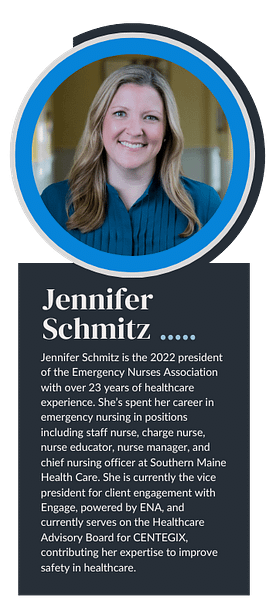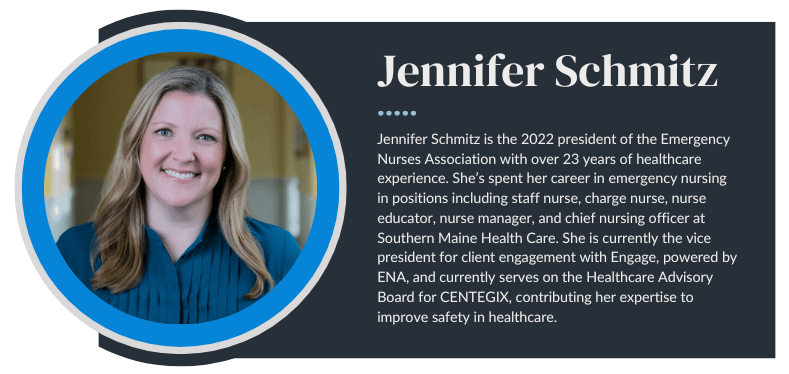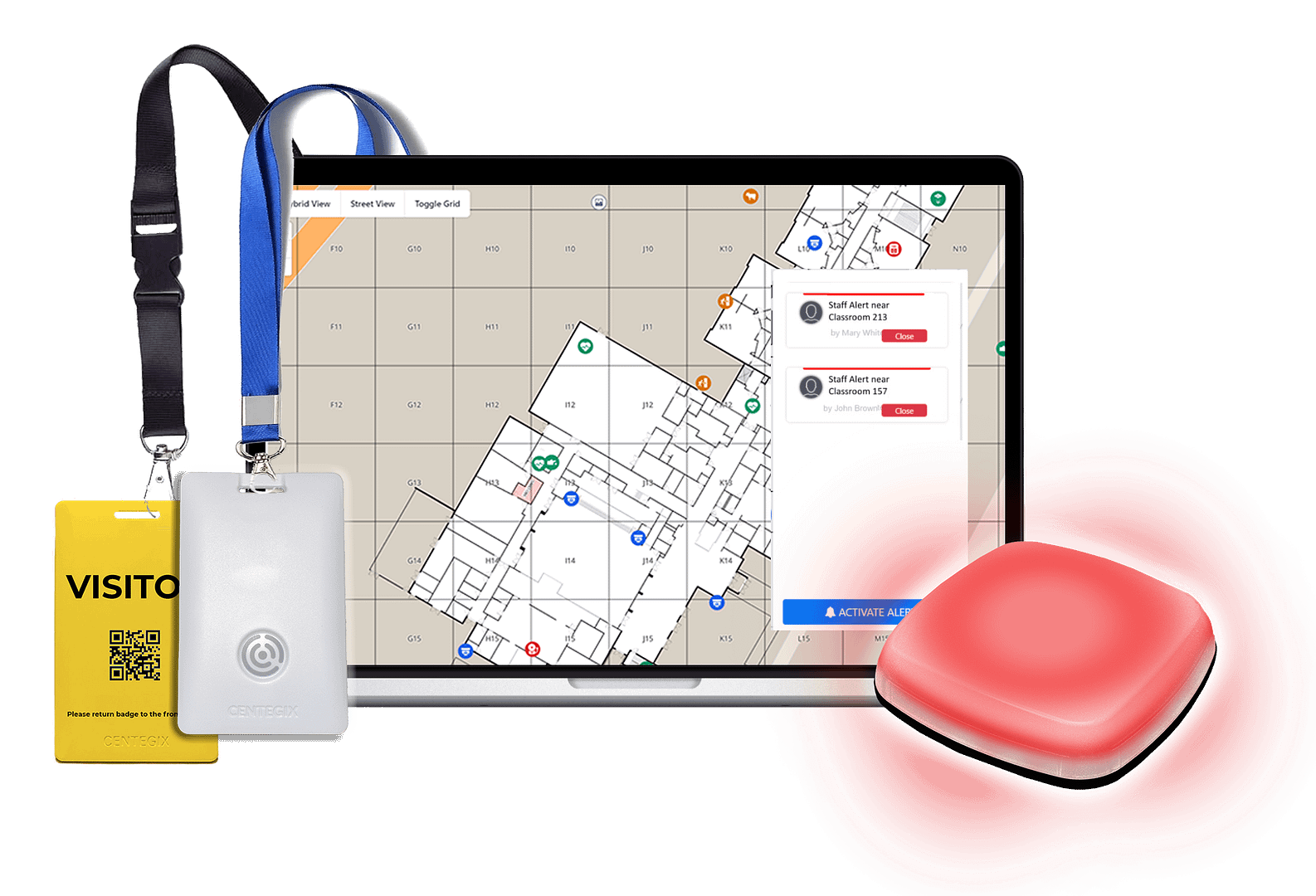
Last month, we sat down with Jennifer Schmitz, MSN, EMT-P, CEN, CPEN, FNP-C, NE-BC to discuss workplace violence in healthcare. As a seasoned healthcare leader, she shared her perspective on the ongoing violence against healthcare workers and what leaders can do to impact the safety of their teams.
Violence against healthcare workers continues to rise. What do you think are some of the biggest contributors?
In healthcare, violent incidents often stem from the stressful situations people find themselves in. It can be incredibly stressful to become a patient, especially for those who weren’t anticipating certain events to occur, and this adds to their overall anxiety.
Being in an environment where individuals may feel a lack of control over the decisions being made about their care can also exacerbate this stress. When people are already on edge, any additional stressors can tip the balance.
How can healthcare leaders begin to combat workplace violence in their facility?
Leaders have a responsibility to manage the issue of workplace violence in a way that supports their team and ensures the safest environment possible. There are several key strategies to consider.
First, a comprehensive assessment of the organization must be conducted This includes reviewing the physical environment, the types of patients being served, and the events occurring. This information helps leaders develop practical actions and steps to enhance safety.
Second, listen to your team. Hearing directly from them on their day-to-day experiences provides valuable insights into what’s happening and how to overcome it. It will also allow your staff to share how the concern of violence impacts them in their work environment.
Lastly, leaders must be open to new ideas and solutions, even those that may not have seemed necessary before. The environment is ever-changing, necessitating new opportunities for mitigating workplace violence.
As a healthcare provider, have you ever felt unsafe at work?
As an emergency nurse, I have absolutely felt unsafe at work. I experienced this both as a staff nurse and then as a leader, when the events occurred within my department. There is one event that will forever stand out for me.
I had a colleague who was choked by a patient. We didn’t have a notification system or any version of wearable technology at the time, so he was not able to call for help. Another staff member just happened to walk by and see it happening, so our team was able to intervene and assist him.
But what if no one had walked by? That’s the part that’s just really unnerving.
That experience sticks with me no matter where I am in my career. It’s one of those things where, as much as we talk about it, when it happens right in front of you, it’s almost surreal.
He ended up being OK – he wasn’t permanently injured – but it was such a terrifying experience for him that he wasn’t able to come back to the emergency department. It was too traumatic.
Many people feel that workplace violence is isolated to emergency departments. What do you think?
Emergency departments and behavioral health units are often the first places people imagine when it comes to workplace violence in healthcare. And while they’re probably ranked highest in terms of the number of incidents, the reality is, events can happen anywhere in a healthcare facility.
As a Chief Nurse, I saw events occur in inpatient settings, labor and delivery, and even outpatient facilities, which are often less prepared to handle such incidents. By raising awareness, we can break the misconception that workplace violence only happens in the ED, because it doesn’t.
How does a wearable duress button, like CrisisAlert, contribute to a comprehensive safety plan?
The CrisisAlert duress button adds a significant layer of safety and security for individuals and their teams. The ability to quickly and discreetly request help is vital.
In emergency departments, for example, it is crucial to be able to notify your colleagues immediately when you feel at risk. This kind of quick communication, without needing to leave the space, is a key factor in managing unplanned events and helping staff feel more secure.
Do you think workplace violence contributes to the healthcare staffing crisis?
Whether you’re a nurse, a caregiver, or anyone working in the healthcare setting, workplace violence impacts your ability to want to stay in that setting. If you don’t feel safe and secure at work, you’re less likely to want to continue working in that environment.
Many nurses get injured and then struggle to return to work because they no longer feel comfortable there. These roles are essential, and we have an obligation to protect them. Ensuring their safety and security helps maintain a stable workforce, which is crucial for the well-being of our communities.
How can solution providers and healthcare leaders work together to impact the future of workplace safety?
There is a complacency related to healthcare that workplace violence is tolerated, and it really shouldn’t be. When I was a bedside nurse, we would tell each other, “Don’t get in the back corner of the room; always be between you and your exit.” I understand the why, but to have to think about where we position ourselves in relation to the patient and an exit…we need something better than that.
CENTEGIX contributes to progress by providing innovative and comprehensive technology that protects individuals and their teams. These measures enhance the overall safety environment.
It’s crucial for hospital leaders to explore these options and be open to integrating safety solutions as part of a comprehensive approach. Financial constraints are often cited as barriers, but it’s essential to recognize the real and pervasive threat of workplace violence. Investing in safety measures can significantly impact the overall well-being of healthcare staff and patients.
At CENTEGIX, we are dedicated to our mission of innovating safety solutions to empower and protect people (every day). In an emergency, time is the most critical factor for a positive outcome. CrisisAlert, a wearable staff duress badge, enables staff to discreetly summon help in an emergency, so they can focus on what matters most: delivering high-quality patient care. Leveraging the CrisisAlert solution, dynamic digital mapping, real-time locating capabilities, and visitor management, the CENTEGIX Safety Platform can help your organization plan for and respond faster to any safety situation anywhere on your campus.
Explore how CrisisAlert can impact safety in healthcare here.












